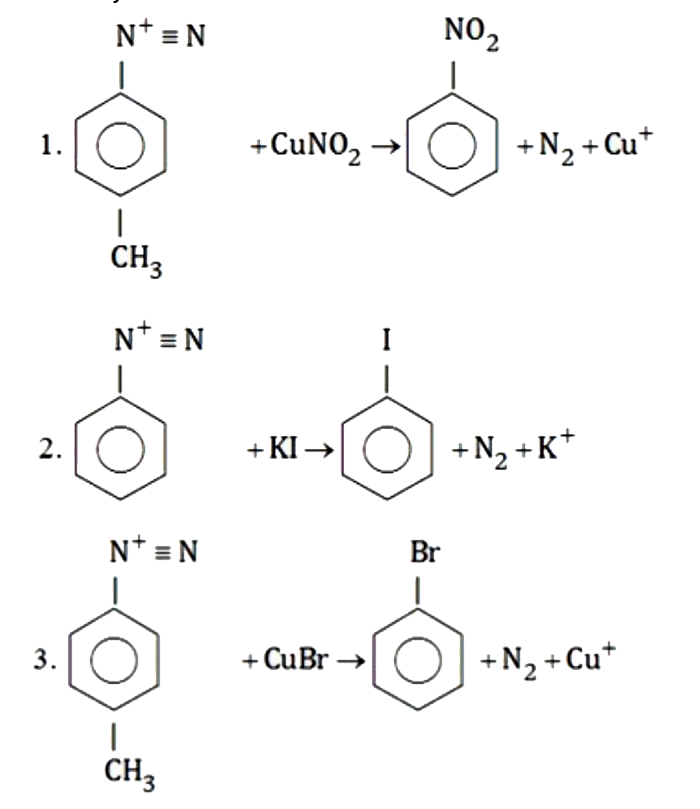Sandmeyer's reaction
Step-by-Step Solution for Sandmeyer's Reaction
Step 1: Formation of Benzene Diazonium Salt
- Start with aniline (C6H5NH2).
- React aniline with sodium nitrite (NaNO2) in the presence of hydrochloric acid (HCl) at a temperature of 0 to 5 degrees Celsius.
- The reaction produces benzene diazonium salt (C6H5N2^+Cl^-) as follows:
C6H5NH2+NaNO2+HCl→C6H5N2+Cl−+NaCl+2H2O
Step 2: Reaction with Copper Halides
- Take the benzene diazonium salt and react it with copper(I) chloride (CuCl) or copper(I) bromide (CuBr).
- The general reaction can be represented as:
C6H5N2+Cl−+CuX→C6H5X+N2+CuCl
where X can be either Cl or Br.
Step 3: Formation of Halogenated Aromatic Compound
- The nucleophile (Cl^- or Br^-) from the copper halide attacks the carbon atom of the diazonium group.
- This results in the substitution of the diazonium group (N2) with the halogen (X), forming chlorobenzene (C6H5Cl) or bromobenzene (C6H5Br).
- Nitrogen gas (N2) is released as a byproduct.
Final Reaction Summary:
- The overall reaction can be summarized as:
C6H5N2+Cl−+CuCl→C6H5Cl+N2+CuCl
- Start with aniline (C6H5NH2).
- React aniline with sodium nitrite (NaNO2) in the presence of hydrochloric acid (HCl) at a temperature of 0 to 5 degrees Celsius.
- The reaction produces benzene diazonium salt (C6H5N2^+Cl^-) as follows:
C6H5NH2+NaNO2+HCl→C6H5N2+Cl−+NaCl+2H2O
- Take the benzene diazonium salt and react it with copper(I) chloride (CuCl) or copper(I) bromide (CuBr).
- The general reaction can be represented as:
C6H5N2+Cl−+CuX→C6H5X+N2+CuCl
where X can be either Cl or Br.
- The nucleophile (Cl^- or Br^-) from the copper halide attacks the carbon atom of the diazonium group.
- This results in the substitution of the diazonium group (N2) with the halogen (X), forming chlorobenzene (C6H5Cl) or bromobenzene (C6H5Br).
- Nitrogen gas (N2) is released as a byproduct.
- The overall reaction can be summarized as:
C6H5N2+Cl−+CuCl→C6H5Cl+N2+CuCl
Topper's Solved these Questions
Similar Questions
(a) Write the structural formula of A, B, C and D in the following sequence of reaction :
CH3−CI∣CH−CH3alc−−→KOHAHBr−−−−→PeroxideBNal−−−−→dry etherCMg−−−−→dry etherD
Illustrate Sandmeyer's reaction with the help of a suitable example.
View SolutionWhat is Sandmeyer reaction ? Illustrate with a suitable example.
View Solution
Knowledge Check
Decrease in free energy of a reacting system indicates:
an exothermic reaction
an endothermic reaction
a spontaneous reaction
a slow reaction.Aan exothermic reactionBan endothermic reactionCa spontaneous reactionDa slow reaction.
Which one of the following are examples of Sandmeyer reaction?


View SolutionGive a brief account of the following with one example of each: Sandmeyer reaction.
View SolutionWhich of the following are intermediates in Sandmeyer reaction ?
(i) C6H5N+≡NCl− (ii) C6H5N+≡N
(ii)C5H5 (iv) C6H5Cl
View SolutionConsider the following conversion :

Amongst the following, how many methods can be used in any one of steps involved in the mentioned conversion?
i. Hoffmann bromamide degradation
ii. Gabriel phthalimide synthesis
iii. Sandmeyer reaction
iv. Clemmensen reduction
v. Mendius reduction
View SolutionGive a brief account of the following reactions:
Hunsdiecker's reaction
View SolutionExplain the following reactions:
Friedel-Craft's reaction
View SolutionIn a reversible reaction, the forward reaction was 3 times faster than that of reverse reaction. The reaction quotient is.....
View Solution
